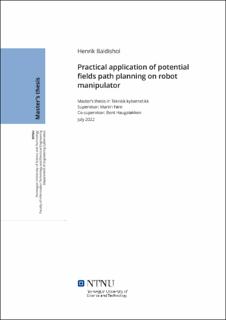| dc.contributor.advisor | Føre, Martin | |
| dc.contributor.advisor | Haugaløkken, Bent | |
| dc.contributor.author | Baldishol, Henrik | |
| dc.date.accessioned | 2022-11-03T18:19:37Z | |
| dc.date.available | 2022-11-03T18:19:37Z | |
| dc.date.issued | 2022 | |
| dc.identifier | no.ntnu:inspera:102231297:49979086 | |
| dc.identifier.uri | https://hdl.handle.net/11250/3030007 | |
| dc.description.abstract | Lakseoppdrett er en av Norges største industrier, med landbasert produksjon basert på innovasjon fra 1980-tallet. Mange teknologiske fremskritt er gjort siden konstruksjonen av de tidligste produksjonsfasilitetene, er industrien fortsatt avhengig av manuel arbeidskraft for de fleste elementene i produksjonsprosessen. Denne oppgaven (i med prosjektet Autosmolt2025) er dedikert til å finne autonome løsninger til en av de mer essensielle undergruppene av disse manuelle arbeidsoppgavene, fjerningen av død fisk og avfall i smolttanker.
Løsningen har blitt jobbet med i oppgaven bruker revolutt-ledd robotmanipulatorer som er montert på en Remotely Operated underwater Vechile (ROV). Kun selve robotmanipulatoren er brukt i oppgaven.
Den teoretiske delen av oppgaven omfatter teori rundt modellering, baneplanlegging og reguleringen som kreves for å styre robotmanipulatorens end-effector mot ønsket posisjon, samtidig som at rotasjonsledd og lenker unngår å kollidere med hindringer i arbeidsområdet.
Løsninger for baneplanlegging ble implementert med bruken av potensialfelt. Dette ble gjennomført ved å modellere tiltrekkende felter som drar robotens rotasjonsledd mot ønsket sluttkonfigurasjon, mens frastøtende felter ble implementert for å styre leddene bort fra hindringer. Minimalisering av potensialer i disse feltene ble brukt som optimaliseringsobjektiv for å gradvis bevege manipulatoren mot ønsket endeposisjon.
Den implementerte metoden med potensiale felter hadde en tendens til å bli fanget i lokale minimum. En "random walk" metode ble implementert for å unngå dette problemet.
Flere tester ble gjennomført for å verifisere at baneplanleggeren klarer å finne kollisjonsfrie baner mellom forskjellige konfigurasjoner. Testene viste at baneplanleggeren fortsatt har problemer med lokale minimum, og at baneplanleggeren ikke klarer å genere komplette baner mellom konfigurasjoner generelt. Optimaliseringsalgoritmen ble forsøkt forbedret ved å implementere Wolfe-kriterier for å begrense steglengden på algoritmen. En feil ble funnet i implementasjonen av Wolfe-kriteriene, som derfor ikke kan brukes i den endelige optimaliseringsalgoritmen.
Banene som ble generert ble deretter brukt til å flytte robotmanipulatoren mellom forskjellige konfigurasjoner. Manipulatoren klarte ikke å følge hele den planlagte banen.
Oppgaven konkluderer med at potensiale felter var utilstrekkelig for et problem av slik kompleksitet. De fleste konfigurasjoner førte til ukomplette baner, da algoritmen ble låst i et lokalt minima. Noen forslag ble gitt til hvordan man kan forbedre delene av algoritmen som ikke virket som konsekvenns av implementasjonen. | |
| dc.description.abstract | Salmon production remains as one of Norways largest industries, with land-based production sites ranging back to the 1980's. While many technological advancements have been made since the construction of the initial sites, the industry still relies heavily on manual workforce. This thesis (in accordance with the Autosmolt 2025 project) is devoted to find autonomous solutions to one of the more essential subgroup of these labors, namely the removal of dead fish and waste in the smolt tanks.
The solution pursued in this thesis made use of a revolute-joint robot manipulator, mounted on a Remotely Operated underwater Vehcile (ROV). The robot manipulator alone is the subject of study for this thesis
The theoretical research in the thesis concerns the modeling, path planning and control theory required to control the robot manipulator's end-effector towards a desired position, while the joints and links of the manipulator avoid potential obstacles in the workspace.
Solutions for path planning were implemented by employing the potential fields method. This was done by modeling attractive fields used to force the robot manipulator's joints towards a desired end configuration, while repulsive fields were implemented to enforce obstacle avoidance. Minimization of potentials in these fields was then used as an optimization objective, in order to incrementally move the manipulator to the desired end position.
The potential fields method is prone to get trapped in local minima of the optimization problem. A method called "randomised walk" was implemented in order to circumvent this issue.
A series of tests were conducted in order to verify the ability of the potential fields path planning algorithm to find collision-free paths between different configurations. The tests revealed that the problem of local minima had not been solved, and the path planning algorithm was not able to generate complete paths for a general set of configurations. An effort was made to improve the optimization algorithm by implementing Wolfe conditions, used to decide how far the optimization algorithm should move towards the minima. An error was found in the implementation of the Wolfe conditions, which meant that they could not be used in the optimization algorithm.
The paths generated were then used to move the robot manipulator between different configuration. The manipulator was not able to follow the full path.
The thesis concluded that the potential fields approach to path planning was inadequate for problems of this complexity. Most configurations would lead to incomplete paths, as the algorithm was trapped in a local minima. Some suggestions were given on how to improve the parts of the algorithm that were faulty due to faulty implementation. | |
| dc.language | eng | |
| dc.publisher | NTNU | |
| dc.title | Practical application of potential fields path planning on robot manipulator | |
| dc.type | Master thesis | |
